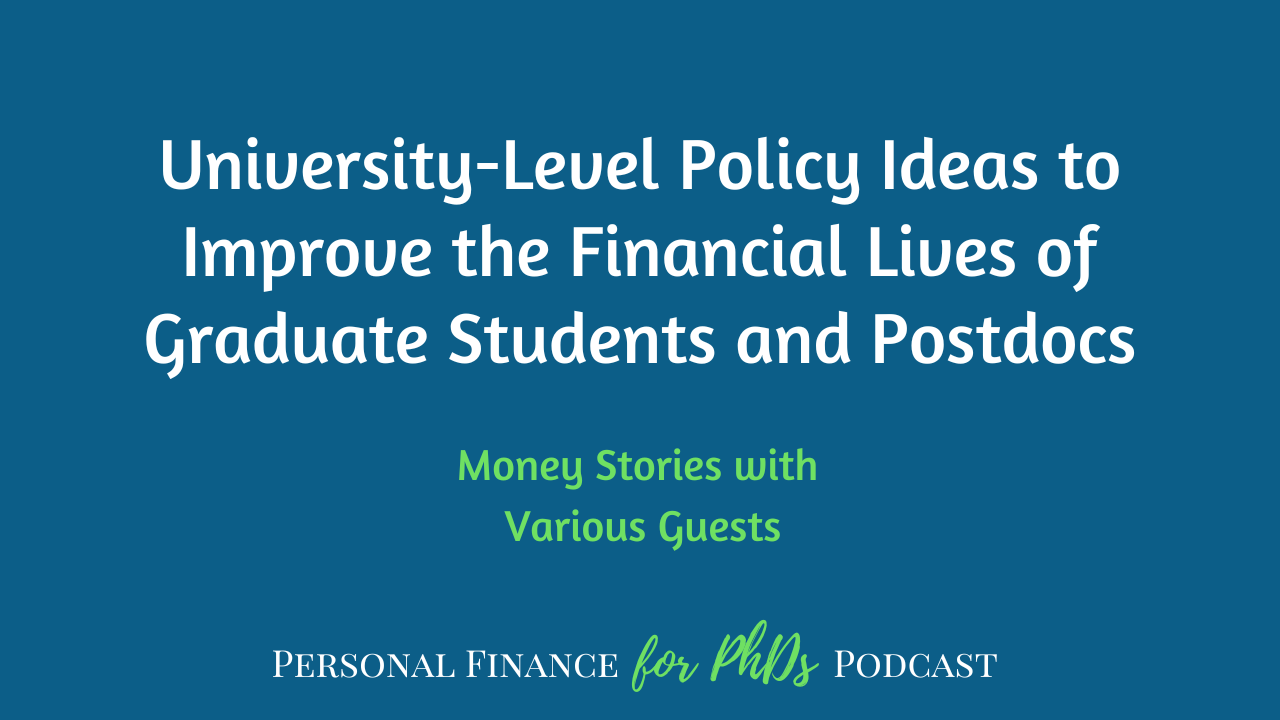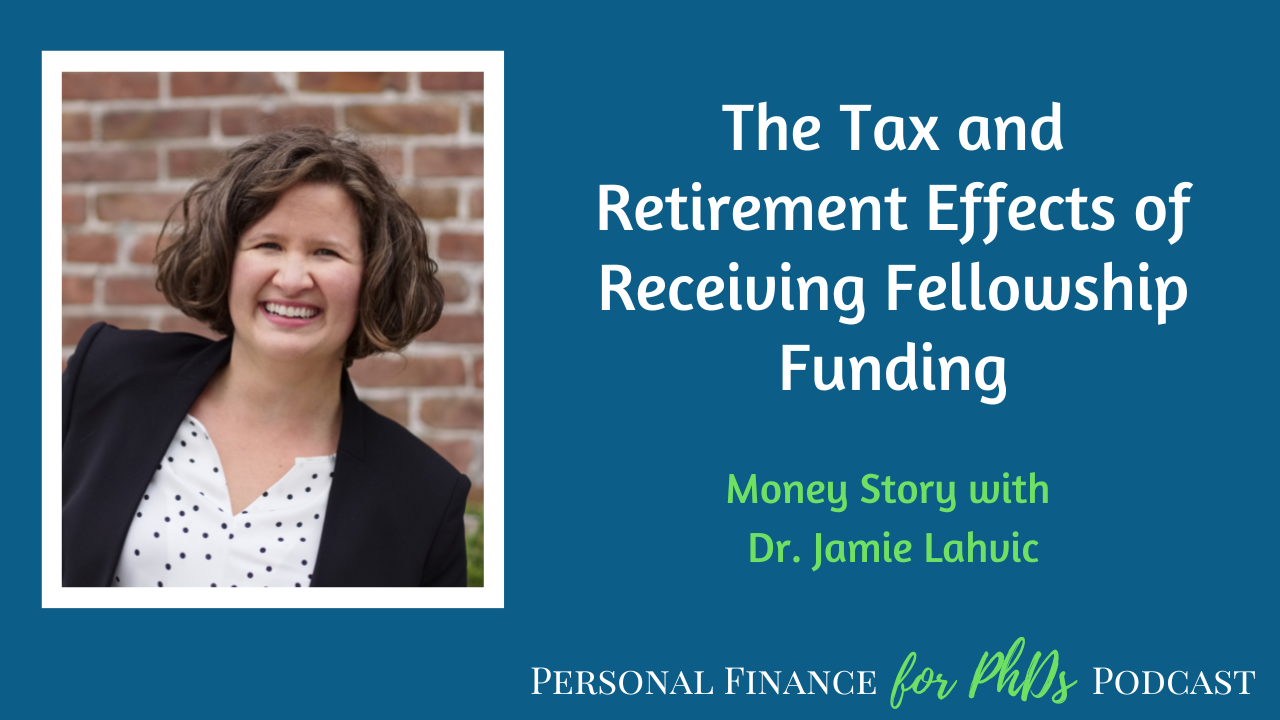In this episode, Emily shares the microinterviews she recorded at two higher education conferences this past summer. The conference attendees, virtually all of whom work at universities and most of whom have PhDs themselves, responded to this prompt: “What policy at your current university or one you worked at or attended in the past would you change to improve the financial lives of the PhD students and/or postdocs?” Listen through the episode for numerous ideas for policy change to advocate for at your university.
Links mentioned in the Episode
- Graduate Career Consortium (GCC) Annual Meeting
- Higher Education Financial Wellness Alliance (HEFWA) Summit
- Host a PF for PhDs Seminar at Your Institution
- Dr. Katy Peplin, Thrive PhD
- Emily’s E-mail Address
- PF for PhDs Subscribe to Mailing List
- PF for PhDs Podcast Hub

Teaser
00:00 Michael D: And the reproduction of knowledge requires financial security. And when you’re in a situation where you’re not getting paid a living wage, it’s very, very difficult to achieve that financial security. So for me, that’s definitely the major policy change that I would love graduate programs across the country to adopt.
Introduction
00:19 Emily: Welcome to the Personal Finance for PhDs Podcast: A Higher Education in Personal Finance. I’m your host, Dr. Emily Roberts, a financial educator specializing in early-career PhDs and founder of Personal Finance for PhDs. This podcast is for PhDs and PhDs-to-be who want to explore the hidden curriculum of finances to learn the best practices for money management, career advancement, and advocacy for yourself and others.
00:50 Emily: This is Season 15, Episode 5, and today I’m sharing the microinterviews I recorded at two higher education conferences this past summer. The conference attendees, virtually all of whom work at universities and most of whom have PhDs themselves, responded to this prompt: “What policy at your current university or one you worked at or attended in the past would you change to improve the financial lives of the PhD students and/or postdocs?” Listen through the episode for numerous ideas for policy change to advocate for at your university. The two conferences I attended were the Graduate Career Consortium Annual Meeting or GCC and the Higher Education Financial Wellness Alliance Summit or HEFWA Summit. GCC is primarily attended by university staff members working with PhD students and postdocs in career and professional development. The HEFWA Summit is attended by university staff members working in financial wellness and financial aid across undergraduate and graduate populations. These two conferences were excellent networking opportunities for me on top of the built-in professional development. However, there are plenty of universities who were not represented at these conferences.
02:10 Emily: Would you please consider recommending my financial education seminars and workshops at your university? My most popularly requested events for the upcoming academic year are How to Survive and Thrive Financially in Graduate School or Your Postdoc, How to Not Hate Your Fellowship During Tax Season, and Up-Level Your Cash Flow as a Graduate Student or Postdoc. Please direct an appropriate potential host within your graduate school, postdoc office, grad student association, etc. to PFforPhDs.com/financial-education/ where they can learn more. Thank you in advance!
02:53 Emily: You can find the show notes for this episode at PFforPhDs.com/s15e5/. Without further ado, here are the microinterviews recorded at GCC and the HEFWA Summit.
What policy at your current university or one you worked at or attended in the past would you change to improve the financial lives of the PhD students and/or postdocs?
Understanding Financial Priorities of International Students: Karin Lawton-Dunn, Iowa State University
03:11 Karin L-D: Okay. So I’m Karin Lawton-Dunn and I’m at Iowa State University. And what policy would you change when you’re current or former university campus to improve financial life for graduate students or postdocs? Since I work primarily with international students, I think I would try to change the understanding of faculty and staff of all of the different priorities that international students have with their money, and so that, you know, they really will go without food, without meals, so that they’re able to send some money home to their families that are also in need and struggling with food and housing. And I think that we need to be understanding of that and not punishing them for doing that.
Fee Exemption: Laura Farrell-Wortman, University of Arizona Cancer Center
03:53 Laura F-W: I’m Laura Farrell-Wortman. I’m the assistant director for academic programs with the University of Arizona Cancer Center. So I think that the policy that I would change would be to exempt PhD students from required fees, because I think that it really is, you know, important revenue generation for the university. But it does feel a little bit like kind of like the company store right where you are getting the money for working there, but that you’re turning right around and giving the money back to the university so it doesn’t feel like it’s a really sustainable system. And I would I would be interested to see what kind of revenue generation they’re actually getting from the PhD students and whether or not that could be found in an alternative means.
Postdoc Stipends and Benefits: Kaylee Steen, University of Michigan Medical School
04:41 Kaylee S: My name is Kaylee Steen. I work at the University of Michigan Medical School, and my advice for changing a policy at our institution that we’re actually implementing is ensuring that all postdocs at least make the minimum NIH stipend for their years of experience at the university. I think is really key. And another policy that we have not implemented would be that postdocs receive the same retirement benefits as are the rest of our staff, with the 2 to 1 matching.
Postdoc Benefits: Chris Smith, Virginia Tech
05:19 Chris S: My name’s Chris Smith. I manage the Office of Post-Doc Affairs at Virginia Tech. And one policy I’d like to see change really across the landscape is treating postdocs more like employees with employee benefits, especially retirement matching. Some institutions do that. We are one of them, but a lot of them don’t. And I think it’s important for them to kind of set them up for success.
Postdoc Training and Benefits: Weiwei Xu, Tulane School of Medicine
05:40 WeiWei X: My name is Weiwei Xu. I’m the academic and career advisor for a biomedical sciences graduate program within the Tulane School of Medicine. I think we can actually provide postdocs with more training programs as well as social benefits and retirement benefits so that they feel more supported by the school and by their training programs.
Cost of Living Adjustments: Beth Hunsaker, University of Utah
06:05 Beth H: My name is Beth Hunsaker with the University of Utah’s Financial Wellness Center. I’m the associate director, and the policy that I would want to see changed is to have cost of living adjustments, how much it costs to have rent. When that’s over half of what their stipend is and they’re not able to go and work somewhere else does doesn’t work for their families.
Consistent Funding and Transparency: Chris Hamm, University at Buffalo
06:28 Chris H: My name is Chris Hamm from the University at Buffalo. And the first prompt it was asking about what policy would you change in your current or previous campus approved financial life for grad students? And for me, just working with graduate students, noticing the opportunities for GA TA and RA positions, we do have, you know, minimum amount of financing for those positions that are agreed upon. But I think it’s not consistent across the board for each of different departments. And also true, since it’s a larger university, it’s very siloed as far as what information’s available to graduate students. So I think being able to have that be a little bit more transparent, giving them the opportunity to be more competitive, get themselves these positions and also make them aware of it, because a lot of times it’s only specifically in departments and I think it’s a really great opportunity because that’s something that I did when I was in grad school as well to help fund my education and get my experiences.
Postdoc Benefits: Alexandra Schnoes, Science Communication Lab
07:22 Alexandra S: Hi, I’m Alexandra Schnoes. I am the director for professional development at the Science Communication Lab. One of the things that I think about a lot is, is how postdocs at different institutions are often under these weird sort of employment categories. They’re often in different employment categories at the same institution. They often don’t have access to things, even though they’re considered employees are also considered trainees. So they also often don’t have access to things like sometimes even health care. But potentially child care support or retirement accounts. And and all of these things are ridiculous. These are these are people with Ph.Ds who are acting as professionals and and they should be able to be treated like you know, the employees that they actually are, as opposed to some weird, crazy, you know, none of the above, which means they get none of the benefits and all of the work of being a postdoc sometimes for years on end, doing amazing work, making the university home. But then they’ve sacrificed finances, potentially health care, retirement accounts, the ability to have children, all of this, all of these are things that policies could actually help address.
Child Care: Kathryn Sawyer Vidrine, University of Notre Dame
08:57 Kathryn SV: So this is Kathryn Sawyer Vidrine from Notre Dame and if I were to change one policy to make life easier on graduate students and post-docs, it would be to provide childcare for children under two years old because there is almost none in our area.
Postdoc Benefits: Peter Myers, Washington University in Saint Louis
09:16 Peter M: My name is Peter Myers. I’m at Washington University in Saint Louis. The one policy that I would change for postdocs would be to make them all employees of the university.
Wages/Stipends: Elizabeth Eikmann, Washington University in Saint Louis
09:30 Elizabeth E: My name is Elizabeth Eikmann. I am the program coordinator for Postdoctoral Community Engagement at Washington University in Saint Louis, and I was a graduate student at Saint Louis University. And if I could change one policy for my former university’s campus to improve the financial life of the grad students there, it would be immediate graduate assistantship raises. The wages currently are not even living wage wages. Graduate assistants there are paid only nine months out of the year instead of 12. So not only implementing a raise but also instituting a year round salary, which also includes year round access to health insurance, which is not currently a policy there on campus.
Retirement Benefits: Maggie Nettesheim Hoffmann, Humanities Without Walls Consortium
10:24 Maggie NH: My name is Maggie Nettesheim Hoffmann. I’m the associate director of Career diversity for the Humanities Without Walls Consortium. Which is a grant for a Mellon funded, grant funded project at space at the University of Illinois at Urbana-Champaign. But I am located at Marquette University in Milwaukee, Wisconsin. So I think the policy advice that I would give and more systemically across, you know, higher education across the nation would be to recommend to universities that you consider one of the benefits for graduate students enrolled in your schools to give them access to starting their own 403b plans while they’re working on their master’s degrees or their PhDs, and making that a real benefit of, you know, if you’re at a public university that has you know, that regard, students are organized, making that a part of your union contract negotiations, aiming at private institutions, right? I mean, it’s not a heavy cost to the institution at all just to give them a framework or structure to start investing into those for all three plants. So that would be one of the policies that I would advocate as a shift in our higher ed, higher education ecosphere. Yeah.
Financial Education: Brady Krien, University of Iowa
11:32 Brady K: So my name is Brady Krien and I work at the University of Iowa, and the policy that I would change on our campus is to actually give us greater latitude to provide resources and information about finances for graduate students, and particularly related to the tax implications of fellowships that they win and how they need to prepare in advance to deal with those.
Financial Education: Yazzmynn Martinez, University of Colorado, Boulder
11:58 Yazzmynn M: Hi, everyone. My name is Yazzmynn Martinez. I am a events education and emergency response coordinator at the University of Colorado Boulder. I work at the Basic Needs center and one policy that I would change about the university campus to improve the financial life of our graduate and postdoc students is to provide a more formal education on basic needs in general so that can include how to get housing before they start college and also how to like budget with groceries and other expenses. And I would also advocate to increase the stipend just because oftentimes that’s not even enough for students to cover their living expenses.
Transparency: Katy Peplin, Thrive PhD
12:45 Katy P: Hi, I’m Katy Peplin from Thrive PHD. You can find me at thrive dash PhD dot com. I work with graduate students all around the world on being a scholar and a human. What policy would be useful. I think that the biggest policy that universities can put in place is transparency. I know so many students who have been caught in between different policies where they weren’t aware that certain things applied to them when they actually did or they lost out on money because things were well communicated. And I know that it’s extra work for universities to make some of those things transparent. But the more information that’s readily and easily accessible, the less grad students have to depend on their departments or their advisors who might not be well informed to let them. Know about opportunities. So transparency.
Commercial
13:31 Emily: Emily here for a brief interlude. Would you like to learn directly from me on a personal finance topic, such as taxes, goal-setting, investing, frugality, increasing income, or student loans, each tailored specifically for graduate students and postdocs? I offer seminars and workshops on these topics and more in a variety of formats, and I’m now booking for the 2023-2024 academic year. If you would like to bring my content to your institution, would you please recommend me as a speaker or facilitator to your university, graduate school, graduate student association, or postdoc office? My seminars are usually slated as professional development or personal wellness. Ask the potential host to go to PFforPhDs.com/speaking/ or simply email me at [email protected] to start the process. I really appreciate these recommendations, which are the best way for me to start a conversation with a potential host. The paid work I do with universities and institutions enables me to keep producing this podcast and all my other free resources. Thank you in advance if you decide to issue a recommendation! Now back to our interview.
Wages/Stipends: Sasha Goldman, Boston University
15:38 Sasha G: I am Sasha Goldman. I am the director of PCE resources at Boston University. And if I could change a policy on my current university campus to improve the financial life of the graduate students and postdocs, I would give everyone 12 months of funding and everyone more money.
Fellowship Payment: Joseph Gonzales, University of Miami
15:56 Joseph G: My name is Joseph Gonzales and I’m the senior director in the Office of Science and Assistance at the University of Miami. And the policy that I would change and this isn’t specifically related to my current campus. It’s based on my experience at different campuses. It’s how people pay like to pay fellowships, and especially when there’s a research component to it, they tend not to use the employment side of it where it would be there would be tax withholdings, because I believe sometimes faculty think that it’s a way to sidestep tax. The tax requirement when they don’t realize that it’s actually basically pushing it down the line for the student to deal with later and sometimes that often students don’t realize that there is a tax liability too, that comes with their financial aid. And by the time they’ve found out they haven’t saved money for that liability. So puts them in this financial crunch, sort of once their taxes are had been filed or they don’t claim it, and then it just gets pushed further down the line. So I would like faculty and universities in general to have said you’re trying to help other people. I don’t know if it’s more of a process that is that are aligned because it changes from one university to the other and how these are handled.
Wages/Stipends: Alex Embree, University of Missouri
17:39 Alex E: My name is Alex Embree. I’m the program manager at the Office for Financial Success for the University of Missouri. And the policy that I would want to have changed is that graduate student payment is in accordance with the value that they bring to the university when they are operating in a teaching capacity or grant. They need to be paid accordingly.
Time to Degree Transparency: Robbie Pearson, Southern Methodist University
18:03 Robbie P: My name is Robbie Pearson, and I’m the director of graduate and postdoctoral graduate career development and post-doc affairs at SMU in Dallas, Texas. And in terms of policies that I would be interested in revising around graduate education to improve the financial life of grad students and postdocs, I’m really interested in time to degree. I would like to see more transparency around how long it takes to earn a doctoral degree, and I’d like to see policies and initiatives around making sure that that’s a reasonable amount of time. Right. So in some fields it could take eight, nine, ten years to earn a doctoral degree or longer. And, you know, there’s some case that that’s important for the intellectual development of the scholar and for the research that they’re contributing to. But I also want to balance that against the reality that graduate students should be thinking of their time in grad student in grad school as an investment, not only into the intellectual development and into their field, but also into their financial futures. So getting them into the workforce in a reasonable amount of time is a really good thing. From my perspective.
Financial Education and Wages/Stipends: Stevie Eberle, Stanford University School of Medicine
19:03 Steve E: Stevie Eberle, executive director and assistant dean of biosecurity at Stanford University School of Medicine. So what policy would you change in your current or former university campus to improve the financial life of graduate students and postdocs? I would. We have an entry level class that all incoming graduate students have to take. And then there is a kind of an intro group that postdocs attend. And I really do wish we had financial training and planning built into the trainings, especially in the Bay Area because it’s so expensive and you you can’t quite understand it until you’re there. So I really would like somebody who can very directly explain the market and directly explain how to navigate it and have the resources to develop that. That being said, I think it is the administration’s responsibility to also help build better structures for that which we are working on, I will say. So we have subsidized housing in that type of thing, but subsidized housing is still very expensive. So I would like to have better pay, better caps, better minimum salaries and better coaching for faculty on how to treat something else. And often treat students and postdocs as more respectfully and more like adults and give them better tools for negotiation. Because I do think sometimes faculty just don’t know that. Sometimes they do, and that’s the problem, but sometimes they don’t. So I’d like to do better education on equitable offers and help better develop those kind of baseline expectations for parents and for this.
Cost Transparency: Derek Attig, University of Illinois, Urbana-Champaign
20:57 Derek A: I’m Derek Attig. I work in the Graduate college at the University of Illinois, Urbana-Champaign. And I’d like to see it be consistent that tuition and fees and the total cost of graduate education is completely transparent to people before they apply and when they’re making the decision to attend so they can understand the costs and weigh that against outcomes they hope to achieve.
Wages/Stipends: Michael Dedmon, National Endowment for Financial Education
21:25 Michael D: My name is Michael Dedmon. I’m the research director at the National Endowment for Financial Education and a Ph.D. candidate in political science at Syracuse University. I can definitely say for me that the single policy change that I would love for my graduate program, which is still sort of considering to adopt, is to raise wages and raise stipends for for graduate students. My department recently unionized, even though I’m an advanced graduate student and no longer in the bargaining unit. It’s something that’s very, very close to my heart that I think is very important. It’s beneficial for universities in terms of recruitment and retention. It reduces time to degree. It reduces attrition. We all know the benefits of it, in addition to the fact that the work that the students put in is what makes the universities work. They’re teaching students, they’re producing research, they’re publishing papers. It’s a beneficial situation for everybody. And the reproduction of knowledge requires financial security. And when you’re in a situation where you’re not getting paid a living wage, it’s very, very difficult to achieve that financial security. So for me, that’s definitely the major policy change that I would love graduate programs across the country to adopt.
Wages/Stipends: Byron Kerr, Texas State University
22:30 Byron K: Hi, I’m Dr. Byron Kerr with Financial aid and scholarships at Texas State University, and I received my Ph.D. from Florida State University in Tallahassee and what I would like to see changed on college campuses is back in the day. At any rate, my stipend check for my for my Ph.D. always came in a month after the payment deadline. So I always generated a $100 late fee every single semester. So I was always costing me money to be employed.
Housing: Anna Sheufelt, Duke University
22:58 Anna S: My name is Anna Sheufelt I work at Duke University, overseeing the educational programing and outreach for the Office of Student Loans and Personal Finance. A policy change that I would love to see come to. My campus is guaranteed housing for our international masters and graduate students. These are folks who have some of the largest complexities going on in their lives and also some of the greatest financial constraints with the international student status.
Wages/Stipends and Tuition: Annie Maxfield, University of Texas at Austin
23:28 Annie M: My name is Annie Maxfield. And I am at UT Austin in Texas. Career engagement and I would say the biggest financial policy problem is that tuition has continually become higher and higher over the years. Yet graduates students stipends are not increasing at that rate. And so we know the university is taking in more funds. However, the distribution of those funds is inequitable in terms of how graduate student labor is actually compensated.
Child Care: Phil Schuman, Indiana University
24:03 Phil S: So my name is Phil Schuman. I’m from Indiana University. One thing I do expect to see for a lot of grad students throughout higher ed is more access to child care and whether or not that’s temporary or permanent or whatever. But just the ability for grad students to be able to focus on their studies, their academics when they have child, if you have childcare issues come up, just because we’ve seen a lot of childcare and daycare cost issues and closing on campus. But I think it’s one thing, it’s a huge barrier that could potentially prevent grad students from getting over that hurdle.
Fellowship Transparency and Experiential Learning for International Students: Sonali Majumdar, Princeton University
24:34 Sonali M: Yeah. Hi, everyone. I am Sonali Majumdar and Assistant Dean for Professional Development in the Grad Futures program of the Graduate School of Princeton University. And I just wanted to talk a little bit about what kind of inclusive policies university campuses could have to support their international graduate students. And most of population on their financial wellness. And there are two things that come to mind. One is transparency on what kind of research fellowships are open to international graduate students and postdocs. And a lot of the universities do have research, Discovery Fellowship. Discovery databases like David Hopkins has a public dashboard that like lists all sorts of fellowships at the Graduate and closed off level by citizenship accessibility as well. And the other thing is experiential learning. What can we do to make experiential learning more accessible to international population? One pathway that does work is our internships and our fellowships that are funded by the institution that the students are working on, and that relates to work policies of how much academic hours on top of academic hours are. Students are available to work at university offices or other units on internships. And so there is definitely some interesting new programs that are helping out in this arena. And I hope more universities would eventually think about accessibility for their international population. On experiential learning. Thank you.
Financial Education: Matt Hertenstein, DePaul University
26:05 Matt H: Hi, my name is Matt Hertenstein, a college professor at DePaul University, received my Ph.D. at U.C. Berkeley in 2000. It may have changed since I graduated, but the policy I would change was to actually teach some financial literacy advice and financial wellness to Ph.Ds and make that a priority during orientation and make sure that people actually knew that that was available to help them.
Health Insurance: Alex Yen, Boston University
26:33 Alex Y: Hi, my name is Alex Yen I am a postdoc at Boston University in the Professional Development and Postdoctoral Affairs office. The policy that I would change or wish could change is that I hope that more universities will allow graduate students who take time off to keep their student health insurance during that time off. So that way they can take care of their mental health while they are recovering or taking some time away.
Outtro
27:14 Emily: Listeners, thank you for joining me for this episode! I have a gift for you! You know that final question I ask of all my guests regarding their best financial advice? My team has collected short summaries of all the answers ever given on the podcast into a document that is updated with each new episode release. You can gain access to it by registering for my mailing list at PFforPhDs.com/advice/. Would you like to access transcripts or videos of each episode? I link the show notes for each episode from PFforPhDs.com/podcast/. See you in the next episode, and remember: You don’t have to have a PhD to succeed with personal finance… but it helps! The music is “Stages of Awakening” by Podington Bear from the Free Music Archive and is shared under CC by NC. Podcast editing by Dr. Lourdes Bobbio and show notes creation by Dr. Jill Hoffman.





